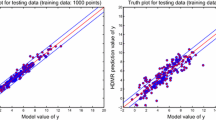Abstract
Basic problems in the use of applied mathematical statistics for the modeling of complex systems are considered; the possibility of establishing the uniqueness of a mathematical model of optimal complexity by the group method of data handling (GMDH) is demonstrated. The basic shortcoming of contemporary mathematical statistics is that the models used are too simple because until now in regression analysis only one mean-squared error criterion has been used. To define a mathematical model of optimal complexity GMDH uses not one but two criteria and these two criteria assure a unique solution. The resulting equations are so complex that only the multilayered structure of GMDH allows us to write them down. The method works not only whenK ⩽N but also whenK >N(Kis the number of coefficients of the regression equation,N is the number of interpolation points). Increasing the area of optimization raises the accuracy of the model. The second criterion should be heuristic. Mean-squared error defined on a test sequence is used. The division of data into training and test sequences is the basic object of so-called “goal-directed regularization.” A second shortcoming of contemporary applied mathematical statistics is the absence of “freedom of decision” in the terminology of D. Gabor. The GMDH selection-type algorithm realizes both the self-organization and “freedom of decision” criteria. GMDH is a nonparametric procedure and does not require many of the concepts of mathematical statistics.
Similar content being viewed by others
References
S. Beer,Cybernetics and Management (The English Universities Press, 1960).
A. G. Ivakhnenko, “Heuristic self-organization in problems of engineering cybernetics,”Automatica 6:207–219 (1970).
A. G. Ivakhnenko, “Polynomial theory of complex systems,” inIEEE Trans. on Systems, Man, and Cybernetics SMC-1(4) (1971).
A. G. Ivakhnenko,Systems of Heuristic Self-Organization in Engineering Cybernetics (Tekhnika Press, Kiev, 1971) (in Russian).
V. V. Nalimov,The Theory of Experiments (Nauka Press, Moscow, 1971) (in Russian).
A. G. Ivakhnenko, Yu. A. Koppa, G. Petrake, and N. A. Todua, “Method of mathematical modeling of complex ecological systems,”Automatika 16(4) (1971) (in Ukrainian; the journal is translated by Scripta Publishing Corp. asSoviet Automatic Control).
A. G. Ivakhnenko and Yu. V. Chukin, “Purposeful regularization for short-term and middle-term prognoses,”Avtomatika 17(1) (1972).
G. A. Panovsky and G. V. Brayer,Statistical Methods in Meteorology (Cozmeteoizdat Press, Leningrad, 1967) (in Russian).
V. N. Stepanenko and V. S. Stepashko, “Analysis of variance of regularity of multiple regression equations for GMDH,”Avtomatika 16(4) (1971).
M. A. Cournot,Exposition de la théorie des chances et des probabilités (Paris, 1843).
V. D. Dimitrov, “Algorithms of GMDH on fuzzy sets of zade,”Avtomatika 15(4) (1970).
“The 4th Competition for Young Scientists,”Avtomatika 16(3) (1971).
A. G. Ivakhnenko,Electrical Automation (Gostekhizdat SSSR, 1957).
V. Vasiliev, “Information approach to the theory of steady states,”Avtomatika 16(2) (1971).
Author information
Authors and Affiliations
Rights and permissions
About this article
Cite this article
Ivakhnenko, A.G. Problems of complex system modeling and applied mathematical statistics. International Journal of Computer and Information Sciences 2, 49–60 (1973). https://doi.org/10.1007/BF00987152
Received:
Revised:
Issue Date:
DOI: https://doi.org/10.1007/BF00987152




